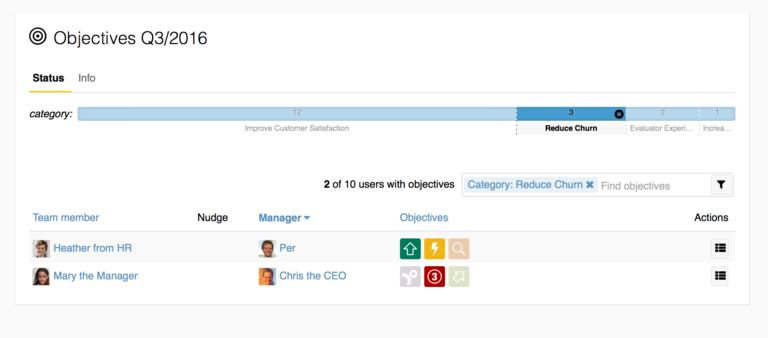
Performance Improvement Plans
At Small Improvements, we believe in fostering growth and providing employees with the tools and support they need to succeed. A Performance Improvement Plan (PIP) isn’t about punishment – it’s about giving employees a clear path to success when they need a little extra guidance.
Table of Contents
At Small Improvements, we believe in fostering growth and providing employees with the tools and support they need to succeed. A Performance Improvement Plan (PIP) isn’t about punishment – it’s about giving employees a clear path to success when they need a little extra guidance.
In this guide, we’ll show you how to use our platform to create a personalized and constructive PIP that sets your employee up for success.
Let’s imagine that a member of the sales team, Salma, has missed her quota for the past two quarters and just received a “Needs Improvement” rating on a recent performance review. We now need to take steps to monitor and document her progress as we work with her to close the gaps in her performance.
-
First, we’ll use objectives to create and track the specific milestones that Salma needs to achieve throughout the plan.
-
Next, we’ll use 1:1 meeting templates to provide her manager with some guidance for their weekly check-ins.
-
Finally, we’ll use automated feedback requests to more formally document her progress at regular intervals.
Objectives
We’ll start by creating some clear and specific goals that we need Salma to achieve by the end of the PIP. We can create an objectives cycle exclusively for the employee, even if you already have other objectives cycles running in parallel. Consider enabling the “Key Results” checklist to outline the specific tasks needed to achieve each goal.
1:1 Meetings
As an HR Admin, you can create a 1:1 Meeting template to provide Salma’s manager with some structure for their check-in conversations over the course of the plan.
Automated Feedback Requests
Finally, automated feedback requests are a great way to document more formal feedback from various stakeholders over the course of the plan.
By leveraging a combination of these key features, you can create a performance improvement plan that ensures your underperforming employee feels supported and motivated to succeed. Remember, a well-implemented performance plan benefits both the employee and the organization, leading to long-term success and growth for everyone involved.
Discover more resources

How to communicate a new performance management process
Invested a lot of time and energy creating a new performance management process? Ensure your efforts achieve impact by crafting a solid communication plan.

Simple Objective Alignment
Does your company have overarching goals that you’d like employees to align with? We’ve shipped some neat improvements to our objectives module that will help you. Improved alignment We added categories and ratings to objective cycles last week. This allows for lean objective alignment towards your quarterly company goals: When employees are creating objectives, they’ll…

Setting goals, the SMART way
Want real results? Then setting realistic and achievable SMART goals is the way to go. Here is an outline of the process and best practices to get you started.

Ready, set, praise
Giving praise has been proven to be an effective motivator. Here’s why praise can be the way to go when your team needs that little push.

Beyond ‘good job’: Unlock meaningful employee recognition with 5 questions
Being noticed and appreciated by others is deeply motivating. Recognition matters, but how do you make recognition meaningful and impactful?

Features you may have missed in 2021
It’s been a productive couple of quarters (with more coming soon!). Here’s a round-up of spring product updates and tips to enhance your performance management process.